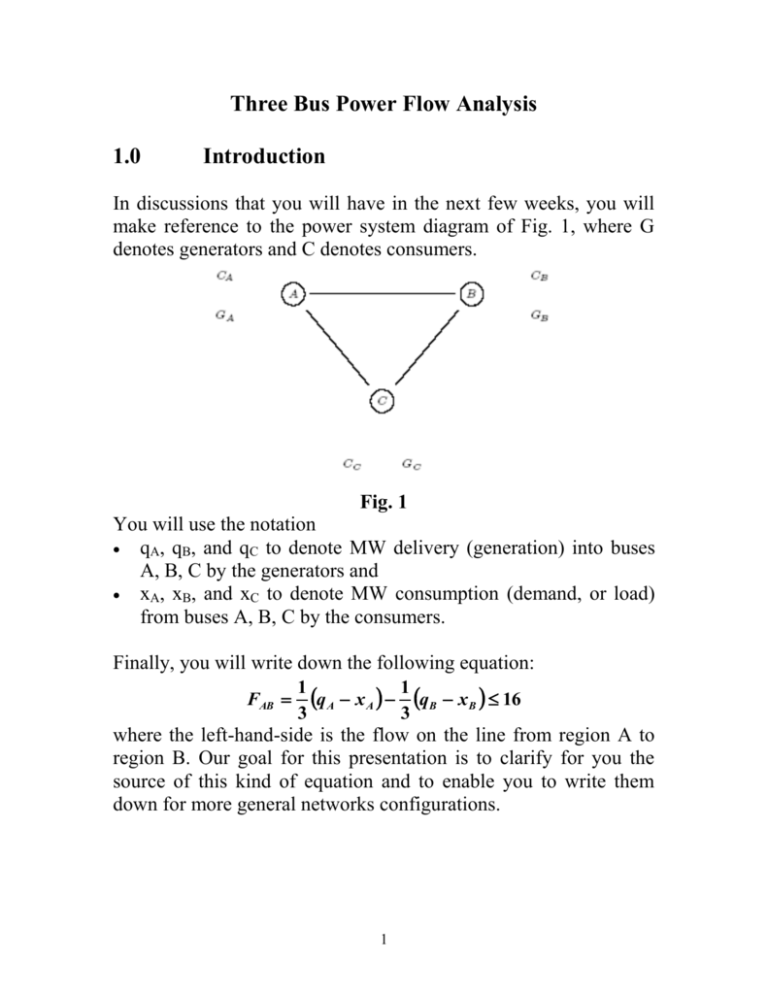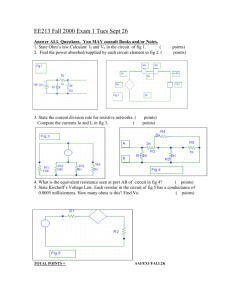Three-bus power flows - Iowa State University
advertisement

Three Bus Power Flow Analysis 1.0 Introduction In discussions that you will have in the next few weeks, you will make reference to the power system diagram of Fig. 1, where G denotes generators and C denotes consumers. Fig. 1 You will use the notation qA, qB, and qC to denote MW delivery (generation) into buses A, B, C by the generators and xA, xB, and xC to denote MW consumption (demand, or load) from buses A, B, C by the consumers. Finally, you will write down the following equation: FAB 1 q A x A 1 qB xB 16 3 3 where the left-hand-side is the flow on the line from region A to region B. Our goal for this presentation is to clarify for you the source of this kind of equation and to enable you to write them down for more general networks configurations. 1 First note that what is inside the parentheses of each term in the above equation is the power injection at nodes A and B, respectively. Let’s make the following assumptions: 1. The impedance of each line is j1 pu. 2. Node C has no active injection but rather is short circuited to ground. 3. We may treat power just like we treat current. With these assumptions, one can apply current division to the network of Fig. 1 to obtain the flow on line A-B. Flow from A to C along line A-B: Path A-C Impedance -------------------------------------------------------Node A Injection Path A-C Impedance+Path A-B-C Impedance 1 q A x A 3 Flow from B to C along line A-B: Path B-C Impedance -------------------------------------------------------Node B Injection Path B-C Impedance+Path B-A-C Impedance 1 qB xB 3 To obtain the composite flow, we subtract Flow computed in (2) from flow computed in (1). Question: On what basis can we make our assumptions 2 and 3? 2 2.0 Conventions and nomenclature We mention at the outset that there are conventions and nomenclature used in the previous page are generally unfamiliar to the power engineer. Convention: The one-line diagram is similar to that drawn in Fig. 1, but the conventional diagram uses lines for nodes, circles for generators, and arrows for loads. Fig. 2 is the one-line diagram that is equivalent to Fig. 1. V1 V2 F12 q2 jx12 q1 jx13 x1 jx23 x2 F13 F23 V3 x3 q3 Fig. 2 Nomenclature: Economists like to use q for supply and x for demand, of anything, including electric power. Power engineers like to use P for any real power quantity: supply, demand (load), or flow, with the only distinguishing difference being (sometimes) the subscripts, e.g., PD1, PG1, P12. In these notes, we will Use q and x for supply and demand, but we will use numerical subscripts instead of A,B,C, e.g., qk,xk, k=1,3. Use Pk to denote the injection into bus, i.e., Pk=qk-xk. We will also use Fkj to denote the real power flow across the circuit connecting buses k and j. 3 We do note, however, that use of xk for load presents some problem, because x is universally used to denote line reactance. We will deal with this by using xjk to denote reactance of the line between buses j and k, and xk to denote the consumption at bus k. Finally, we will use (only briefly), Vk to denote the voltage (a phasor) at bus k, | Vk| the magnitude, and θk the angle. This nomenclature is used in Fig. 2. 3.0 A basic power relation Consider a single transmission line connecting two buses, as shown in Fig. 3. V1 V2 F12 q2 jx12 q1 x1 x2 Fig. 3 A very basic relation for power system engineers, which EEs learn in EE 201, expresses the real power flow across a transmission circuit as: F12 V1 I 12 cos (1) Here, φ is the angle by which the voltage leads the current and is called the power factor angle. If we assume that electric loads are purely resistive, so that only real power flows in the network, then φ≈0 (φ will not be exactly zero because of line reactance). In this case, eq. (1) is: F12 V1 I 12 (2) 4 A basic fact of power systems is that the voltages usually do not deviate significantly from their nominal value. Under a system of normalization (called per-unit), where all voltages are normalized with respect to this nominal voltage, it will be the case that |Vk|≈1.0. As a result, eq. (2) becomes: F12 I 12 (3) In other words, the numerical value of the real power flowing on the circuit is the same as the numerical value of the current magnitude flowing on that circuit (under the system of normalization). If, again, the electric load is purely resistive, then all currents will have almost the same angle, and one can treat the current magnitude as if it were the current phasor (and in phase with voltages, so that if we assume any one voltage or current is at 0 degrees, then all voltage and currents will be at zero degrees). Useful conclusion: If we assume voltage magnitudes are all unity, and all loads are purely resistive, then whatever rules we have of dealing with currents also work with real power flows! 4.0 Drawing a circuit from a one-line diagram Our goal here is to draw the one-line diagram of Fig. 2 as an electric circuit. To do that, we will model the generation q1, q2, q3, and the loads, x1, x2, and x3, as power injections (a similar notion as a current injection). We will use the circuit symbol for current source, which is , to model these power injections (which makes sense because, as concluded in Section 3.0, we can treat real power just as we treat currents). 5 Noting that Fig. 2 shows 3 different buses, the circuit drawing will need the same number of nodes with an additional one for ground. Each generator appears as a power source from ground, like this: Each load appears as a power “source” into ground, like this: The circuit drawing for the one-line diagram of Fig. 2 is shown in Fig. 4. F12 jx13 F12 F23 jx12 q1 x1 jx23 q2 x2 q3 x3 Fig. 4 5.0 Netting the power sources Since the two power “sources” at each node are in parallel, we can “net” them to get a single power source corresponding to what we have previously defined as the power injection: Pk=qk-xk. Note that the power injection is Positive if generation qk is larger than load xk Negative if generation qk is smaller than load xk. The resulting circuit is shown in Fig. 5. 6 F13 jx13 F12 F23 jx12 P1 jx23 P2 P3 Fig. 5 6.0 Accounting for power balance Power balance is required, meaning, for a lossless system, the total net power injection must be zero, i.e., P1 P2 P3 0 (4) This means that power injections may only be specified at 2 nodes, and then power injection at 3rd node is determined. Let’s assume that the node where the power injection is determined is node 3. Therefore: P3 ( P1 P2 ) (5) It is common in power system engineering to refer to node 3 as the “swing bus” or “slack bus.” The proper way to model the branch which includes P3, in order to account for eq. (5), is to make it a short circuit. One can easily see that this is the case by writing a KCL equation at the ground node of our circuit, as in Fig. 6. 7 F13 jx13 F12 F23 jx12 P1 Node 3 jx23 P3 P2 P1 P2 P3 0 Fig. 6 Note, however, that P3 is now a short circuit, with current determined by the network, and not a source (with current specified). Two comments are in order here: Our assumption that all voltage magnitudes (including the “ground”) are 1.0 means that the node 3 voltage magnitude is not zero. The fact that voltages are phasors and thus have a magnitude and an angle, means that the voltages may differ at the various nodes, even though their magnitudes are the same (see Section 8 below for “Ohm’s Law for real power flow for more on interpretation of angles). 7.0 Obtain currents in branches We desire to obtain the branch flows to see if the above circuit results in what was used in previous notes, which was eq. (1), repeated here for convenience: FAB 1 q A x A 1 qB x B 3 3 (1) There are several ways we could analyze the circuit of Fig. 6. For example, we can write 2 KCL equations at nodes 1 and 2 as a 8 function of voltage variables at those nodes (and we will do so later). For now, let’s take a simpler way: superposition, where we compute flows from each source one at a time, and then add the results for a given circuit from each calculation. We begin with P1, according to the circuit of Fig. 7. F13 jx13 F12 F23 jx12 jx23 P3 P1 Fig. 7 Using current division, it is immediately apparent from Fig. 7 that: jx13 F12(1) F23(1) P1 jx jx jx 23 13 12 (6) jx12 jx 23 F13(1) P1 (7) jx12 jx 23 jx13 (i ) where we have used notation F jk to denote flow from node j to node k due to power source at node i. Now we analyze source at node 2, P2, using the circuit of Fig. 8. 9 F13 jx13 F12 F23 jx12 jx23 P3 P2 Fig. 8 Again, using current division, we see that: jx 23 F12( 2 ) F13( 2 ) P2 jx12 jx 23 jx13 jx12 jx13 F23( 2 ) P2 jx12 jx 23 jx13 (8) (9) The total flows will then be the sum of the individual flows from each source. Therefore (and canceling the j’s): x13 x23 F12 F12(1) F12( 2 ) P1 P 2 (10) x x x x x x 23 13 23 13 12 12 x12 x13 x13 F23 F23(1) F23( 2 ) P1 P 2 (11) x12 x23 x13 x12 x23 x13 x12 x23 x23 F13 F13(1) F13( 2 ) P1 P 2 (12) x x x x x x 12 23 13 12 23 13 When x12=x13=x23=1, then these equations are: 1 1 F12 P1 P2 3 3 10 (13) 1 2 F23 P1 P2 3 3 2 1 F13 P1 P2 3 3 (14) (15) We see that eq. (13) is the same as eq. (1) FAB 1 q A x A 1 qB x B 3 3 (1) with P1=qA-xA and P2=qB-xB. 8.0 Ohm’s Law For Real Power Flow Let’s return to Fig. 3, repeated here for convenience: V1 V2 F12 q2 jx12 q1 x1 x2 Fig. 3 Another fundamental relation for power flow F12 (learned by EE students in EE 303) is: F12 V1 V2 sin1 2 x12 (16) We will derive this equation later in the course. Here, θ1 and θ2 are the angles of the voltage phasors at buses 1 and 2 respectively. Recall that we applied some approximations to eq. (1). One of these was that |V1|=|V2|≈1.0 under a special system of normalization, i.e., all voltage magnitudes are unity. We will apply this approximation here as well. 11 We will also apply another approximation here, and that is that θ1-θ2, the angular separation across the transmission circuit, is relatively small. This means that the sin function of eq. (16) has a small argument. The situation is illustrated in Fig. 9. Fig. 9 One observes from Fig. 9 that the vertical distance denoted by the dark, small line segment, which is the sin of the corresponding unit circle, is almost exactly the same as the radial distance around the corresponding circumference of the circle. This radial distance is exactly the denoted angle, when we measure the angle in radians. In other words, sin1 2 1 2 (17) Applying eq. (17) to eq. (16), and using |V1|=|V2|≈1.0, we get: 1 2 F12 (18) x12 Consider thinking of the left-hand side of eq. (18) as current (which we have already been doing). This means that, if we think of the angles (when measured in radians) as voltages, then eq. (18) is “Ohm’s Law for Real Power Flow” !!! With this, let’s go back to Fig. 6, repeated here for convenience. 12 F13 jx13 F12 F23 jx12 P1 jx23 P3 P2 P1 P2 P3 0 Fig. 6 9.0 Relation between real power injections and angles As promised in Section 7.0, let’s write 2 KCL equations at nodes 1 and 2 as a function of voltage variables at those nodes, using “Ohm’s Law for Real Power Flow.” It will be: 1 2 1 P F F 1 12 13 Node 1: (19) x12 x13 2 1 2 Node 2: P2 F23 F12 x x (20) 23 12 Collecting terms with common angles in both (19) and (20), we get: 1 1 1 2 P1 1 (21) x12 x12 x13 1 1 1 2 x12 x x 23 12 Writing eqs. (21) and (22) in matrix form, we get: P2 1 13 (22) 1 1 1 P1 x12 x13 x12 1 P 1 1 1 (23) 2 2 x12 x12 x 23 The matrix of eq. (23) has a special name. It is called the B’ matrix and represents the relation of power injections to the angles of the bus voltage phasors in our 3-bus network. We can now specify a procedure to get the real power flows based on eq. (23). This is called the DC Power Flow Procedure. 1. Given power injections, solve (23) for angles. 2. Use angles to compute power flows on branches (see eqs. (19) and (20). 14








